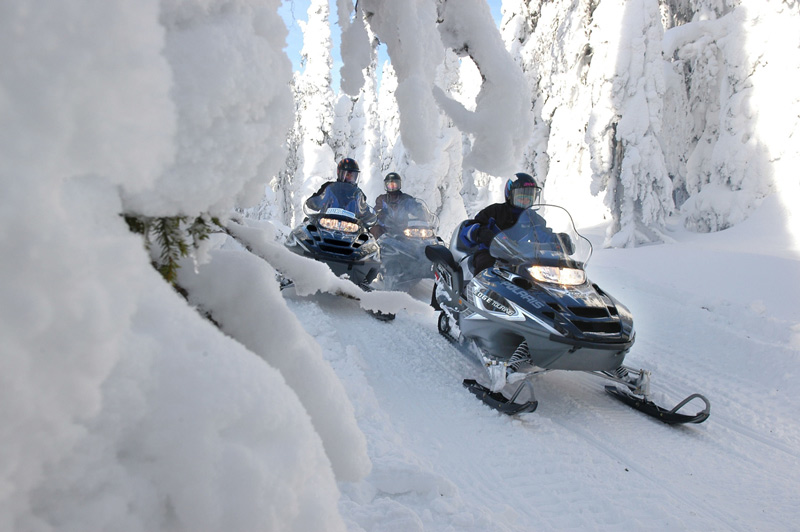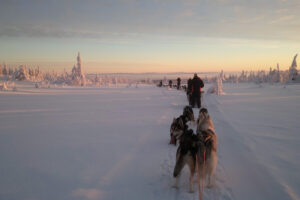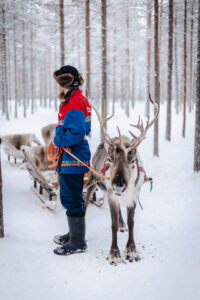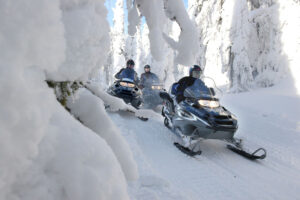Dressing appropriately for Lapland winter activities requires understanding the three-layer clothing system that protects you in Arctic conditions where temperatures can drop to -30°C. The key is combining moisture-wicking base layers, insulating mid-layers, and weather-resistant outer layers that work together to regulate body temperature during varied activities. This approach keeps you comfortable whether you’re racing across frozen landscapes on a husky safari or standing still to photograph the Northern Lights.
What is the layering system for Lapland winter activities?
The layering system consists of three distinct layers that work together to manage moisture, retain warmth, and protect against wind and snow. Your base layer sits against your skin and wicks moisture away, preventing the dampness that causes rapid heat loss. The mid-layer provides insulation by trapping warm air close to your body. The outer layer shields you from wind, snow, and moisture whilst allowing perspiration to escape.
This system outperforms single-layer approaches because it adapts to changing conditions and activity levels. When you’re active during a snowmobile expedition, your body generates heat and moisture. The base layer moves this moisture away from your skin, whilst the breathable outer layer releases it into the air. During stationary activities like Northern Lights viewing, all three layers work together to retain maximum warmth.
Materials matter considerably in Arctic clothing layers. Merino wool and synthetic fabrics excel as base layers because they manage moisture effectively, unlike cotton which absorbs sweat and loses insulating properties when wet. Fleece, down, or synthetic insulation work brilliantly for mid-layers. Your outer layer should feature waterproof, breathable fabrics that keep snow out whilst preventing overheating during active pursuits.
What specific clothing items do you need for outdoor activities in Lapland?
Essential Lapland winter clothing includes thermal underwear (top and bottom) as your base layer, fleece or wool mid-layers, an insulated winter jacket rated for extreme cold, waterproof winter trousers, and winter boots rated to at least -20°C. You’ll also need wool socks, insulated mittens or gloves, a warm hat covering your ears, and a neck warmer or balaclava to protect exposed facial skin.
Temperature ratings guide your choices for outdoor activities in Lapland. Winter boots should handle temperatures of -20°C to -40°C, particularly for stationary activities. Your jacket needs adequate insulation for sub-zero conditions, typically with down or high-quality synthetic fill. Mittens keep fingers warmer than gloves because your fingers share warmth, though you might prefer thin glove liners inside mittens for activities requiring dexterity.
Different activities demand specific adjustments to your basic winter gear Finnish Lapland outfit. Husky sledding involves periods of standing on runners where wind chill becomes significant, so extra face protection and hand warmers prove valuable. Northern Lights photography requires maintaining warmth whilst staying still for extended periods, making thicker mid-layers and insulated boots crucial. We provide appropriate clothing for our Riisitunturi husky experience, ensuring guests have suitable gear for the three-hour adventure through majestic fell landscapes.
Hand and foot warmers serve as excellent backup warmth sources. Pack spare wool socks and an extra pair of gloves in your daypack. These items weigh little but provide security if your primary gear becomes wet or proves insufficient for conditions.
How should you dress differently for various Lapland winter activities?
Active pursuits like snowmobiling, husky sledding, and reindeer rides generate body heat through movement, requiring fewer or lighter mid-layers than stationary experiences. During high-energy activities, you’ll want to avoid overheating by adjusting layers before you start sweating. Stationary activities such as Northern Lights viewing or photography sessions demand maximum insulation because your body produces minimal heat whilst standing still in Arctic temperatures.
Movement level directly affects your body temperature and clothing needs throughout your Lapland packing list preparations. When you’re snowmobiling at speed, wind chill dramatically increases cold exposure on your face and hands, necessitating excellent outer layer protection and face coverage. During a gentle reindeer sleigh ride, you’ll appreciate thicker mid-layers because you’re moving slowly through cold air without generating significant body heat.
Quick layer adjustments make the difference between comfort and misery during Arctic clothing layers management. Remove your mid-layer before starting physically demanding activities, then add it back during rest periods. Keep your outer layer on to block wind, but open ventilation zips when you’re working hard. This prevents moisture buildup that will chill you later when activity levels decrease.
Special activities require specific cold weather clothing Arctic considerations. Ice floating demands completely waterproof gear, typically provided by activity operators as specialist equipment. Photography sessions need mittens that convert to fingerless gloves, allowing camera operation without exposing hands to dangerous cold. When planning multiple activities in one day, dress for the least active pursuit and remove layers as needed for more energetic adventures.
What are the most common clothing mistakes visitors make in Lapland?
The most frequent error travellers make is wearing cotton base layers that absorb and hold moisture against the skin, causing rapid heat loss in Arctic conditions. Other common mistakes include overdressing before activities begin, which leads to sweating and subsequent chilling, and neglecting extremities like fingers and toes where frostbite risk is highest. Many visitors prioritise fashion over function, choose inadequate footwear, or fail to bring backup gloves and socks.
Underestimating wind chill during snowmobile rides catches many people unprepared. The combination of speed and cold air creates dangerous conditions for exposed skin, making face protection absolutely essential. Similarly, visitors often fail to test their gear before heading outdoors, discovering too late that boots are uncomfortable or gloves are insufficient.
Avoiding these mistakes requires planning your what to wear in Lapland winter wardrobe carefully. Choose synthetic or wool base layers exclusively, leaving cotton items at home. Start with fewer layers than you think necessary, knowing you can add more if needed. Ensure your winter boots fit properly with thick socks, and break them in before your trip to avoid blisters during long outdoor activities.
If clothing fails during an activity, communicate immediately with your guide. Professional operators carry spare equipment and can adjust itineraries to ensure safety. At our Lake Livo location, we assist guests with gear recommendations before activities and provide suitable clothing for experiences like our husky safaris. We understand that proper Arctic clothing makes the difference between an uncomfortable ordeal and an unforgettable adventure.
Pack backup items for critical gear. An extra pair of mittens and wool socks weigh almost nothing but provide essential security. Hand and foot warmers offer additional protection when conditions prove more challenging than expected. Remember that staying warm in Lapland winter clothing isn’t about suffering through cold, it’s about understanding how layering, materials, and activity levels work together to keep you comfortable whilst experiencing the magic of Finnish Lapland with exciting activities in the Arctic wilderness.







